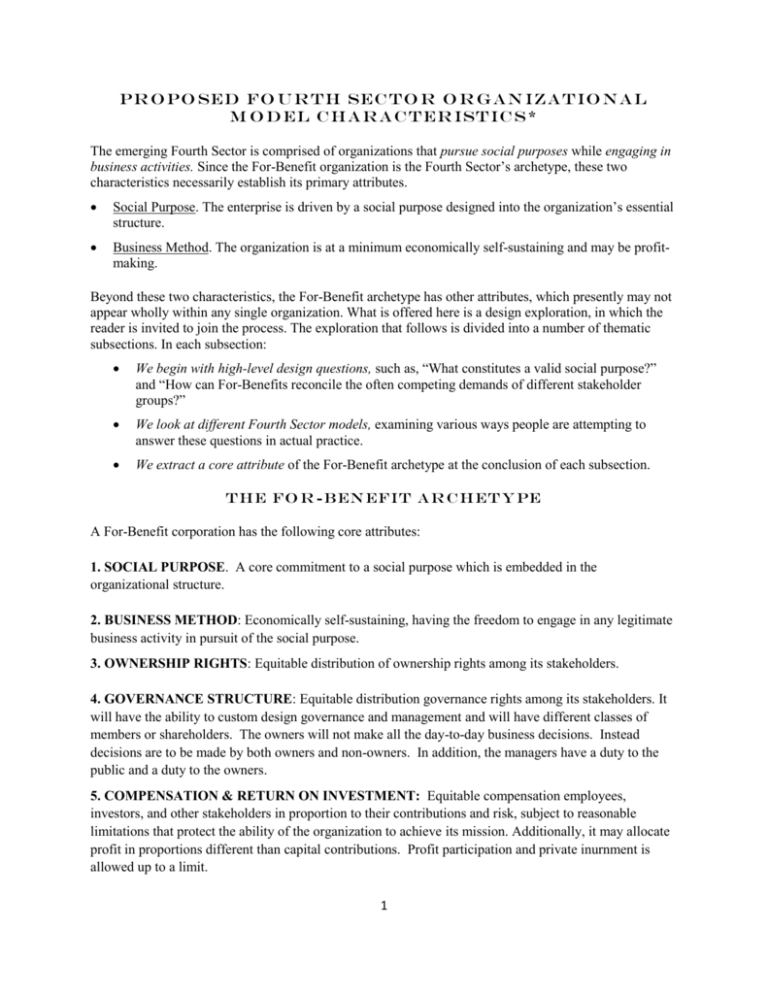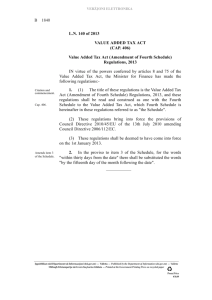Development of the essential characteristics for the Fourth Sector
advertisement

Pr o po sed Fo u r th Sec to r O r g a n iza t io n a l M o d el C h a r a c t er ist ic s* The emerging Fourth Sector is comprised of organizations that pursue social purposes while engaging in business activities. Since the For-Benefit organization is the Fourth Sector’s archetype, these two characteristics necessarily establish its primary attributes. Social Purpose. The enterprise is driven by a social purpose designed into the organization’s essential structure. Business Method. The organization is at a minimum economically self-sustaining and may be profitmaking. Beyond these two characteristics, the For-Benefit archetype has other attributes, which presently may not appear wholly within any single organization. What is offered here is a design exploration, in which the reader is invited to join the process. The exploration that follows is divided into a number of thematic subsections. In each subsection: We begin with high-level design questions, such as, “What constitutes a valid social purpose?” and “How can For-Benefits reconcile the often competing demands of different stakeholder groups?” We look at different Fourth Sector models, examining various ways people are attempting to answer these questions in actual practice. We extract a core attribute of the For-Benefit archetype at the conclusion of each subsection. T h e Fo r -B en efit Ar c h ety pe A For-Benefit corporation has the following core attributes: 1. SOCIAL PURPOSE. A core commitment to a social purpose which is embedded in the organizational structure. 2. BUSINESS METHOD: Economically self-sustaining, having the freedom to engage in any legitimate business activity in pursuit of the social purpose. 3. OWNERSHIP RIGHTS: Equitable distribution of ownership rights among its stakeholders. 4. GOVERNANCE STRUCTURE: Equitable distribution governance rights among its stakeholders. It will have the ability to custom design governance and management and will have different classes of members or shareholders. The owners will not make all the day-to-day business decisions. Instead decisions are to be made by both owners and non-owners. In addition, the managers have a duty to the public and a duty to the owners. 5. COMPENSATION & RETURN ON INVESTMENT: Equitable compensation employees, investors, and other stakeholders in proportion to their contributions and risk, subject to reasonable limitations that protect the ability of the organization to achieve its mission. Additionally, it may allocate profit in proportions different than capital contributions. Profit participation and private inurnment is allowed up to a limit. 1 6. RESPONSIBILITIES BEYOND MISSION: Commitment to having a net positive social and environmental impact. 7. TRANSPARENCY: Commitment to full and accurate assessment and reporting of its social, environmental, and financial performance. This will be achieved and monitored through an annual reporting requirement. 8. LIMITED LIABILITY: Limited liability structure such that the directors of the organization will not be held personally responsible for the actions of the organization as long as the directors conduct any business activity that is consistent with its social purpose and stakeholder obligations. 9. INCOME Ability to conduct any business activity that is consistent with its social purpose and stakeholder obligations. 10. CAPITALIZATION: Ability to accept debt and equity investments as well as tax deductible donations. 11.TAXATION: Ability to accept tax deductible donations and exemption on certain business taxes. 12. REGULATION: No regulation on joint venture; however, there may be restrictions on what type of purpose a For-Benefit organization may pursue. 13. DISSOLUTION: lock on assets that prevent them from being privatized upon terminal events. *Excerpt taken from the Fourth Sector Concept Paper entitled The Emerging Fourth Sector by Heerad Sabeti and the Fourth Sector Concept Group. Click here for the Executive Summary. 2











